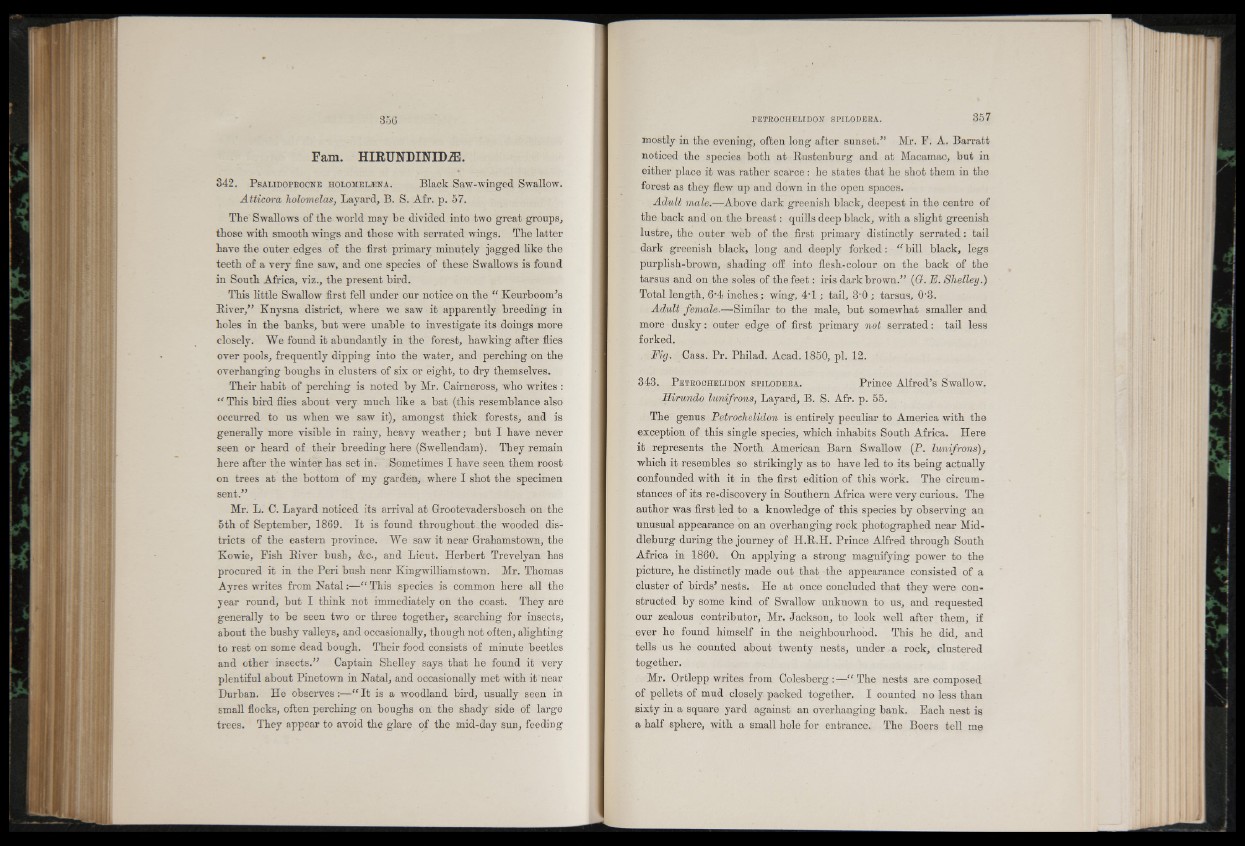
Fam. HIRUNDINIM.
342. P salidopbocne holomeIuEn a . Black Saw-w in g e d Swallow.
Atticora holomelas, Layard, B. S. Afr. p. 57.
The Swallows of the world may he divided into two great groups,
those with smooth wings and those with serrated wings. The latter
have the outer edges of the first primary minutely jagged like the
teeth of a very fine saw, and one species of these Swallows is found
in South Africa, viz., the present bird.
This little Swallow first fell under our notice on the “ Keurboom’s
River,” Knysna district, where we saw it apparently breeding in
holes in the banks, but were unable to investigate its doings more
closely. We found it abundantly in the forest, hawking after flies
over pools, frequently dipping into the water, and perching on the
overhanging boughs in clusters of six or eight, to dry themselves.
Their habit of perching is noted by Mr. Cairneross, who writes :
“ This bird flies about very much like a bat (this resemblance also
occurred to us when we saw it), amongst thick forests, and is
generally more visible in rainy, heavy weather; but I have never
seen or heard of their breeding here (Swellendam). They remain
here after the winter has set in.: Sometimes I have seen them roost
on trees at the bottom of my garden, where I shot the specimen
sent.”
Mr. L. C. Layard noticed its arrival at Grootevadersbosch on the
5th of September, 1869. It is found throughout the wooded districts
of the eastern province. We saw it near Grahamstown, the
Kowie, Fish River bush, &c., and Lieut. Herbert Trevelyan has
procured it in the Peri bush near Kingwilliamstown. Mr. Thomas
Ayres writes from Natal:—“ This species is common here all the
year round, but I think not immediately on the coast. They are
generally to be seen two or three together, searching for insects,
about the bushy valleys, and occasionally, though not often, alighting
to rest on some dead bough. Their food consists of minute beetles
and other insects.” Captain Shelley says that he found it very
plentiful about Pinetown in Natal, and occasionally met with it near
Durban. He observes :—“ It is a woodland bird, usually seen in
small flocks, often perching on boughs on the shady side of large
trees. They appear to avoid the glare of the mid-day sun, feeding
mostly in the evening, often long after sunset.” Mr. P. A. Barratt
noticed the species both at Rustenburg and at Macamac, but in
either place it was rather scarce: he states that he shot them in the
forest as they flew up and down in the open spaces.
Adult male.—Above dark greenish black, deepest in the centre of
the back and on the breast: quills deep black, with a slight greenish
lustre, the outer web of the first primary distinctly serrated: tail
dark greenish black, long and deeply forked: “ bill black, legs
purplish-brown, shading off into flesh-colour on the back of the
tarsus and on the soles of the feet: iris dark brown/' (6?. E. Shelley.)
Total length, 6-4 inches; wing, 4 '1 ; tail, 3-0 ; tarsus, 0'3.
Adult female.—Similar to the male, but somewhat smaller and
more dusky: outer edge of first primary not serrated: tail less
forked.
. Fig. Cass. Pr. Philad. Acad. 1850, pi. 12.
343. P et eo che lido n s pilod eba . Prince Alfred’s Swallow.
Hirundo lunifrons, Layard, B. S. Afr. p. 55.
The genus Petrochelidon is entirely peculiar to America with the
exception of this single species, which inhabits South Africa. Here
it represents the North American Bam Swallow (P. lunifrons),
which it resembles so strikingly as to have led to its being actually
confounded with it in the first edition of this work. The circumstances
of its re-discovery in Southern Africa were very curious. The
author was first led to a knowledge of this species by observing an
unusual appearance on an overhanging rock photographed near Mid-
dleburg during the journey of H.R.H. Prince Alfred through South
Africa in 1860. On applying a strong magnifying power to the
picture, he distinctly made out that the appearance consisted of a
cluster of birds’ nests. He at once concluded that they were constructed
by some kind of Swallow unknown to us, and requested
our zealous contributor, Mr. Jackson, to look well after them, if
ever he found himself in the neighbourhood. This he did, and
tells us he counted about twenty nests, under a rock, clustered
together.
Mr. Ortlepp writes from Colesberg :—“ The nests are composed
of pellets of mud closely packed together. I counted no less than
sixty in a square yard against an overhanging bank. Each nest is
a half sphere, with a small hole for entrance. The Boers tell me